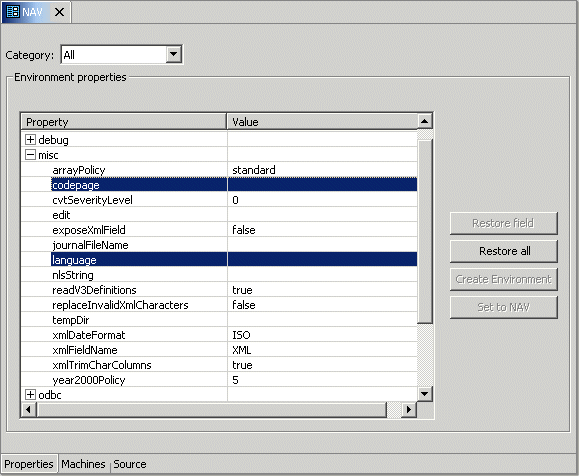|
Oracle® Application Server Adapter for Tuxedo User's Guide
10g Release 2 (10.1.2) B15802-01 |
|
 Previous |
 Next |
|
Oracle® Application Server Adapter for Tuxedo User's Guide
10g Release 2 (10.1.2) B15802-01 |
|
 Previous |
 Next |
OracleAS Adapter for Tuxedo provides the globalization support for the following languages:
Arabic.
English (the default).
Hebrew.
Japanese.
Korean.
Simple Chinese.
Spanish.
Traditional Chinese.
This appendix describes how to define the language support.
The language and codepage parameters are accessed from the computer where Oracle Studio is installed. Using Oracle Studio, perform the following steps:
From the Start menu, select Programs, Oracle, and then select Studio.
Select the computer defined in "Configuring OracleAS Adapter for Tuxedo in Oracle Studio".
Right-click NAV and select Edit Binding.
In the Binding Properties tab, click the misc node.
The NAV Binding Properties tab is displayed in the following figure:

Enter a valid value for the language. The following language codes are valid:
ARA: Arabic.
ENG: English.
HEB: Hebrew.
JPN: Japanese.
KOR: Korean.
SCHI: Simple Chinese.
SPA: Spanish.
TCHI: Traditional Chinese.
Optionally, in the codepage field, specify the codepage required.
You can skip this step, and just specify a language (see the previous step). In this case, a default codepage is used. The following shows the default codepages:
ARA: AR8ISO8859P6.
ENG: ASCII.
HEB: IW8ISO8859P8.
JPN: JA16SJIS on all platforms except for Solaris Operating System (SPARC), where the default is JA16EUC.
KOR: KO16KSC5601.
SCHI: ZHS16CGB231280.
SPA: ASCII.
TCHI: ZHT16BIG5.